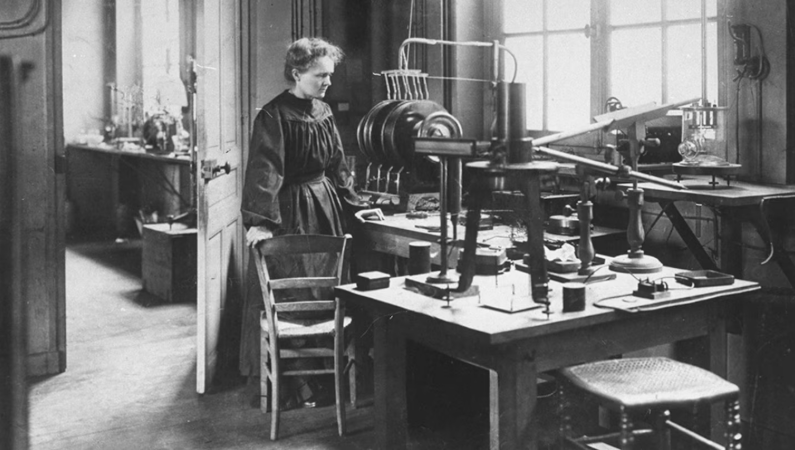
If you’ve ever seen your insides on an x-ray, you can thank Marie Curie’s understanding of radioactivity for being able to see them so clearly.
Born Maria Sklodowska in Poland on November 7, 1867, to a father who taught math and physics, she developed a talent for science early. But the University of Warsaw, in the city where she lived, did not allow women students. Determined to become a scientist and work on her experiments, she moved to Paris, France, to study physics at a university called the Sorbonne.
In 1895, she married Pierre Curie. Together they discovered two new elements, or the smallest pieces of chemical substances: polonium (which she named after her home country) and radium. In 1903 they shared (along with another scientist whose work they built on) the Nobel Prize in physics for their work on radiation, which is energy given off as waves or high-speed particles. She was the first woman to win any kind of Nobel Prize.
Curie continued to rack up impressive achievements for women in science. In 1906, she became the first woman physics professor at the Sorbonne. In 1909, she was given her own lab at the University of Paris. Then in 1911, she won a Nobel Prize in chemistry. She’s still the only person—man or woman—to win the Nobel Prize in two different sciences.
In 1914, during World War I, she created mobile x-ray units that could be driven to battlefield hospitals in France. Known as Little Curies, the units were often operated by women who Curie helped train so that doctors could see broken bones and bullets inside wounded soldiers’ bodies.
After the war ended in 1918, Curie returned to her lab to continue working with radioactive elements. But those can be dangerous in very large doses, and on July 4, 1934, Curie died of a disease caused by radiation. By that time, though, she’d proven that women could make breakthroughs in science, and today she continues to inspire scientists to use their work to help other people.
原创编写 版权所有 侵权必究! 每日更新 个性化阅读 英语飙升!
1.1.What forced Marie Curie to move to Paris?
A Her father worked in France.
B The ban on women students.
C Her marriage to Pierre Curie.
D The discovery of new elements.
解析:选B。B 细节理解题。根据第二段中的“But the University of Warsaw, in the city where she lived, did not allow women students. ”但她在所居住的城市——华沙的那所大学,并不招收女生,以及“she moved to Paris, France, to study physics at a university called the Sorbonne.”她前往法国巴黎,在一所名为索邦大学的院校里学习物理学。故选B。
2.2.What does the underlined part “rack up” mean in Paragraph 4?
A Break or damage sth.
B Give or send sth.
C Lose or miss sth.
D Get or collect sth.
解析:选D。D 词义猜测题。“rack up” 后接 “impressive achievements”(卓越成就),结合后续具体成就的列举,可推断该短语意为 “获得、积累”。故选D。
3.3. What were “Little Curies” used for?
A Helping treat wounded soldiers.
B Training women in science.
C Doing experiments on radiation.
D Teaching in battlefield schools.
解析:选A。A 细节理解题。根据第五段中的 “so that doctors could see broken bones and bullets inside wounded soldiers’ bodies”以便医生能够看到受伤士兵体内骨折的部位和子弹的所在位置,由此可知“Little Curies” 即移动 X 光设备的作用是帮助医生查看伤员体内情况,辅助治疗,对应 “helping treat wounded soldiers”。故选A。
4.4.What is the passage mainly about?
A Marie Curie’s great achievements.
B The discovery of radioactive elements.
C Marie Curie’s two Nobel Prizes.
D The history of mobile X-ray units.
解析:选A。A 主旨大意题。全文围绕居里夫人的生平展开,涵盖其求学经历、科学发现、诺贝尔奖、教学成就及一战中的贡献,并且文章开篇就提到“那要感谢的是玛丽·居里对放射性的理解”。B、C、D 选项仅为文章中某一具体细节,无法概括全文;只有 A 选项 “伟大成就” 能涵盖所有核心内容。故选A。
